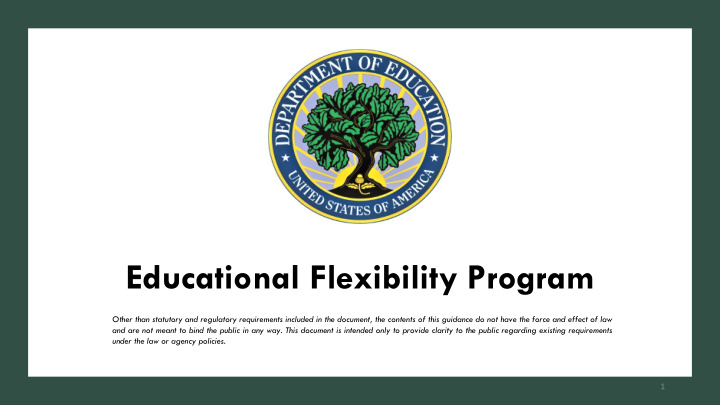



Educational Flexibility Program Other than statutory and regulatory requirements included in the document, the contents of this guidance do not have the force and effect of law and are not meant to bind the public in any way. This document is intended only to provide clarity to the public regarding existing requirements under the law or agency policies. 1
Objectives As a result of this session, participants will be able to: Understand the purpose of the Educational Flexibility Program (Ed-Flex), including the regulations and requirements that are eligible to be waived, and Identify the requirements for applying for Ed-Flex. 2
Agenda Educational Flexibility Partnership Act – Overview – Authority – Eligibility – Requirements – Prohibitions Application Process Questions 3
The Educational Flexibility Partnership Act 4
EDUCATIONAL FLEXIBILITY PROGRAM OVERVIEW Through Ed-Flex, the Secretary delegates to eligible State educational agencies (SEAs) the authority to waive certain statutory or regulatory education requirements that may impede local efforts to reform and improve education. It is designed to help local educational agencies (LEAs), educational service agencies (ESAs), and schools carry out educational reforms and raise the achievement levels of all children. 5
EDUCATIONAL FLEXIBILITY PROGRAM REAUTHORIZATION The Every Student Succeeds Act was signed into law on December 10, 2015 and reauthorized the Ed-Flex program. Ten Ed-Flex States were operating under the prior Ed Flex authority through SY 2018-19. – These States will need to reapply if they are interested in continuing to have this authority. All States that meet the eligibility criteria may apply for Ed Flex authority for SY 2019-20. SEAs may be granted Ed-Flex authority for up to five years. 6
EDUCATIONAL FLEXIBILITY PROGRAM ELIGIBILITY CRITERIA The Ed-Flex statute defines an eligible State, or “Ed-Flex Partnership State” as a State that— (A) Has— (1) Developed and implemented the challenging State academic standards, and aligned assessments, described in paragraphs (1) and (2) of section 1111(b) of the Elementary and Secondary Education Act of 1965 (ESEA), as amended by the ESSA,2 and is producing the report cards required by ESEA section 1111(h); or (2) Adopted new challenging State academic standards under ESEA section 1111(b)(1), made substantial progress (as determined by the Secretary) toward developing and implementing such standards and toward producing the report cards required under ESEA section 1111(h); 7
EDUCATIONAL FLEXIBILITY PROGRAM ELIGIBILITY CRITERIA (CONTINUED) • (B) Will hold LEAs, ESAs, and schools accountable for meeting the educational goals described in the local Ed-Flex applications and for engaging in technical assistance and, as applicable and appropriate, implementing comprehensive support and improvement activities and targeted support and improvement activities under ESEA section 1111(d); and • (C) has waived or will waive State statutory or regulatory requirements relating to • education while holding LEAs, ESAs, or schools within the State that are affected by such waivers accountable for the performance of the students who are affected by such waivers. • (20 U.S.C. § 5891b(a)(2)) 8
EDUCATIONAL FLEXIBILITY PROGRAM REQUIREMENTS The Ed-Flex waiver authority applies to the following sections of the ESEA— 1. Title I, Part A (Basic Programs Operated by LEAs, other than section 1111) 2. Title I, Part C (Migrant Education); 3. Title I, Part D (Neglected and Delinquent) 4. Title II, Part A (Supporting Effective Instruction); and 5. Title IV, Part A (Student Support and Academic Enrichment Grants) The Ed-Flex authority may also be used to waive requirements under the Perkins Career and Technical Education Program. 9
EDUCATIONAL FLEXIBILITY PROGRAM PROHIBITIONS The Ed-Flex program does NOT authorize an SEA to waive any statutory or regulatory requirements relating to: 1. Standards, Assessments, and Accountability requirements under section 1111 of the ESEA 2. Maintenance of effort 3. Comparability of services 4. Equitable participation of students and professional staff in private schools 5. Parental participation and involvement 6. Distribution of funds to LEAs 7. Serving eligible school attendance areas in rank order in accordance with section 1113(a)(3) of the ESEA 10
EDUCATIONAL FLEXIBILITY PROGRAM PROHIBITIONS The Ed-Flex program does NOT authorize an SEA to waive any statutory or regulatory requirements relating to: 8. The selection of a school attendance area or school under ESEA section 1113(a) and (B), except that a SEA may grant a waiver to allow a school attendance area or school to participate in activities under Title I, [Part A] if the percentage of children from low-income families in the school attendance area of such school or who attend such school is not less than 10 percentage points below the lowest percentage of such children for any school attendance area or school of the local educational agency that meets the requirements of such subsections 9. Use of Federal funds to supplement, not supplant, non-Federal funds 10. Applicable civil rights requirements 11. Any requirements that apply to the SEA 11
EDUCATIONAL FLEXIBILITY PROGRAM APPLICATION INFORMATION • The new Ed-Flex FAQs and Application have been released: https://www2.ed.gov/programs/edflex/index.html 12
EDUCATIONAL FLEXIBILITY PROGRAM Questions? 13
Contact Information Give us a call and send us a line: SGR@ed.gov 202-453-5563 [State].OESE@ed.gov (for example, Alaska.OESE@ed.gov) 14
15
Recommend
More recommend